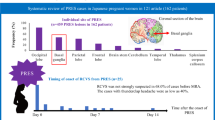Abstract
Background
Posterior reversible encephalopathy syndrome (PRES) is manifested by acute neurological symptoms in patients with varied predisposing factors and characteristic findings on brain imaging. Cerebrovascular autoregulation is thought to be altered in PRES. However, it remains unclear whether cerebral hypoperfusion or hyperperfusion is the initiating event. We aimed to describe the brain perfusion status in untreated patients with PRES.
Methods
Patients with PRES who underwent cerebral perfusion studies on presentation were retrospectively identified from (1) a prospective database of patients with PRES admitted to Saint Mary’s Hospital, Mayo Clinic, Rochester from January 2005 to December 2021 and (2) University of Nebraska Medical Center electronic database from January 2010 to December 2021. Demographics, past medical history, presenting symptoms, cause of PRES, and clinical outcomes were recorded. Brain imaging studies were reviewed. We recorded the location of brain lesions, the time from symptoms onset to perfusion study, blood pressure at the time of the perfusion study, and blood pressure lowering treatments.
Results
Five patients (four women, median age 66 years) were included. Causes of PRES were acute hypertension (n = 3), perioperative blood pressure fluctuations, and treatment with pazopanib. Four patients had chronic hypertension. Presenting symptoms were encephalopathy (n = 5), focal neurological symptoms (n = 4), and seizures (n = 2). All patients underwent computed tomography (CT) perfusion performed within 12 h of symptoms onset. All but one patient was hypertensive at the time of CT perfusion. Scans showed diffuse cerebral hypoperfusion, more pronounced in the corona radiata and areas with brain edema. No patient had critical cerebral ischemia or arterial vasoconstriction on CT angiogram.
Conclusions
Patients with PRES can have cerebral hypoperfusion despite severe hypertension. A perfusion study in the acute setting may be helpful to better understand the perfusion status and guide blood pressure treatment.



Similar content being viewed by others
References
Fugate JE, Rabinstein AA. Posterior reversible encephalopathy syndrome: clinical and radiological manifestations, pathophysiology, and outstanding questions. Lancet Neurol. 2015;14:914–25.
Sheikh-Bahaei N, Acharya J, Rajamohan A, Kim PE. Advanced imaging techniques in diagnosis of posterior reversible encephalopathy syndrome (PRES). Front Neurol. 2020;11:165.
Sarbu N, López-Rueda A, Chirife O, Capurro S. CT-perfusion time-maps likely disclose the earliest imaging signs of posterior reversible encephalopathy syndrome (PRES). J Neuroradiol. 2014;41:147–9.
Sanelli PC, Jacobs MA, Ougorets I, Mifsud MJ. Posterior reversible encephalopathy syndrome on computed tomography perfusion in a patient on “Triple H” therapy. Neurocrit Care. 2005;3:46–50.
Casey SO, McKinney A, Teksam M, Liu H, Truwit CL. CT perfusion imaging in the management of posterior reversible encephalopathy. Neuroradiology. 2004;46:272–6.
Brubaker LM, Smith JK, Lee YZ, Lin W, Castillo M. Hemodynamic and permeability changes in posterior reversible encephalopathy syndrome measured by dynamic susceptibility perfusion-weighted MR imaging. AJNR Am J Neuroradiol. 2005;26:825–30.
Engelter ST, Petrella JR, Alberts MJ, Provenzale JM. Assessment of cerebral microcirculation in a patient with hypertensive encephalopathy using MR perfusion imaging. AJR Am J Roentgenol. 1999;173:1491–3.
Bartynski WS, Boardman JF. Catheter angiography, MR angiography, and MR perfusion in posterior reversible encephalopathy syndrome. AJNR Am J Neuroradiol. 2008;29(447–55):9.
Naidu K, Moodley J, Corr P, Hoffmann M. Single photon emission and cerebral computerised tomographic scan and transcranial Doppler sonographic findings in eclampsia. Br J Obstet Gynaecol. 1997;104:1165–72.
Vanacker P, Matias G, Hagmann P, Michel P. Cerebral hypoperfusion in posterior reversible encephalopathy syndrome is different from transient ischemic attack on CT perfusion. J Neuroimaging. 2015;25:643–6.
Oehm E, Hetzel A, Els T, et al. Cerebral hemodynamics and autoregulation in reversible posterior leukoencephalopathy syndrome caused by pre-/eclampsia. Cerebrovasc Dis. 2006;22:204–8.
Hedna VS, Stead LG, Bidari S, et al. Posterior reversible encephalopathy syndrome (PRES) and CT perfusion changes. Int J Emerg Med. 2012;5:12.
Wartenberg KE, Parra A. CT and CT-perfusion findings of reversible leukoencephalopathy during Triple-H therapy for symptomatic subarachnoid hemorrhage-related vasospasm. J Neuroimaging. 2006;16:170–5.
Li Y, Gor D, Walicki D, et al. Spectrum and potential pathogenesis of reversible posterior leukoencephalopathy syndrome. J Stroke Cerebrovasc Dis. 2012;21:873–82.
Rabinstein AA, Mandrekar J, Merrell R, Kozak OS, Durosaro O, Fugate JE. Blood pressure fluctuations in posterior reversible encephalopathy syndrome. J Stroke Cerebrovasc Dis. 2012;21:254–8.
Mueller-Mang C, Mang T, Pirker A, Klein K, Prchla C, Prayer D. Posterior reversible encephalopathy syndrome: do predisposing risk factors make a difference in MRI appearance? Neuroradiology. 2009;51:373–83.
Funding
None.
Author information
Authors and Affiliations
Contributions
Maximiliano A. Hawkes: study design, data collection, analysis and interpretation of data, and draft of article. Mania Hajeb: data collection, analysis and interpretation of data, and review of article for intellectual content. Alejandro A. Rabinstein: study design, data collection, interpretation of data, and draft of article. The final manuscript was approved by all authors.
Corresponding author
Ethics declarations
Conflict of interest
The authors have no conflicts of interest to declare.
Ethical approval/informed consent
This manuscript adheres to ethical guidelines. The investigation was approved by the institutional review board in both institutions. Informed consent was waived.
Additional information
Publisher's Note
Springer Nature remains neutral with regard to jurisdictional claims in published maps and institutional affiliations.
Supplementary Information
Below is the link to the electronic supplementary material.
Rights and permissions
Springer Nature or its licensor (e.g. a society or other partner) holds exclusive rights to this article under a publishing agreement with the author(s) or other rightsholder(s); author self-archiving of the accepted manuscript version of this article is solely governed by the terms of such publishing agreement and applicable law.
About this article
Cite this article
Hawkes, M.A., Hajeb, M. & Rabinstein, A.A. Perfusion Deficits in Patients with Posterior Reversible Encephalopathy Syndrome: a Retrospective, Two-Center Study. Neurocrit Care 38, 726–732 (2023). https://doi.org/10.1007/s12028-022-01642-9
Received:
Accepted:
Published:
Issue Date:
DOI: https://doi.org/10.1007/s12028-022-01642-9




